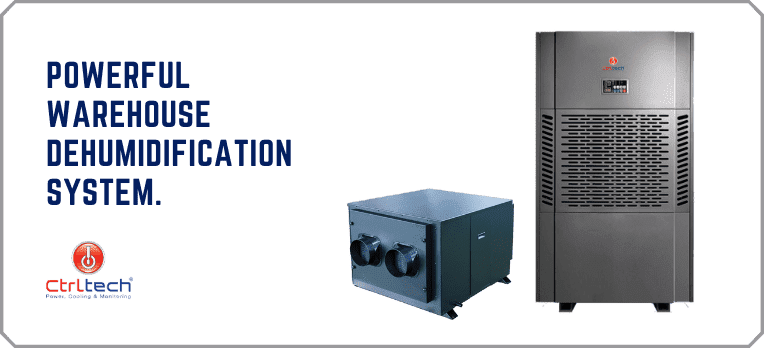Choosing the best commercial warehouse dehumidifier is crucial for any business that requires greater climate management. During the selection process, decision makers must examine a variety of criteria, including the following:

The physical space or amount of air contained within a facility—typically measured in cubic feet—is the first factor to consider when selecting the appropriate dehumidifier unit.
T It is vital to understand the volume of air that will flow through a unit before sizing it. Multiple units may be required if a single unit is unable to handle the facility's air volume.
There are numerous factors to consider when it comes to perforated ..
SKU: CT-DEHUM-WD-XXXL
MPN: CT-DEHUM-WD-XXXL
Category: Warehouse dehumidifier.
Several elements often associated with local or regional climate conditions, such as relative humidity and seasonal or year-round temperatures, will affect unit performance requirements. The number of loading bay doors, the frequency with which they are opened, and the amount of time outside air is allowed to enter the facility all contribute to the dehumidifier unit's performance.
The level of moisture control necessary for an industrial environment varies according to the contents. Certain objects and inventory are more moisture-sensitive than others. Facilities with continuous or high-frequency operation of people and machinery typically include extra temperature control systems such as heating, cooling, or air filtration. Units utilised in these environments will need to meet stricter performance criteria and interface with these additional climate control features.
A warehouse dehumidifier operates in the same manner as a conventional dehumidifier. What differentiates it from a standard dehumidifier is that the warehouse dehumidifier is designed for more powerful purposes; it allows you greater control over the interface, is constructed to handle tough conditions, and has a larger water storage capacity.
A dehumidifier is a device that regulates the humidity level in an area. It might take the form of a device or a series of vents. In either scenario, the machine draws in the air and freezes it; the water vapour in the air condenses and the condensation is left behind as water droplets—this is accomplished by the refrigerating cubes within a dehumidifier. The water is then sent to a tank where all available water is collected.
Warehouses are wet, tight spaces that keep a lot of valuable items that may contain mechanical objects. Humidity is created within warehouses, corroding these things. To protect them from moisture and to ensure the success of hundreds of grant applications, you'll need a dehumidifier that works in any setting.
When shopping for a dehumidifier, you will come across a variety of different models, and in order to choose the finest one, you will need some understanding about their house dehumidifier.
There are two types of dehumidifiers: condensation and desiccant. The condensation unit is utilised for swimming pools, residential spaces, and other regions that experience high levels of humidity.
You'll need a desiccant unit for your warehouse to keep the cold and moisture out. These are typically utilised in regions that are colder, such as a curling facility or a warehouse. If you further categorise it, you'll discover two further sorts.
The first is a portable warehouse dehumidifier, and the second is a dehumidifier that is wall- or ceiling-mounted. The portable warehouse dehumidifier is ideal for smaller warehouses, but if you have a larger warehouse that serves as industrial storage or an aircraft hanger, you will need a wall-mounted or ceiling-mounted warehouse dehumidifier.
If you live in the UAE and require a dehumidifier, visit CTRLtech to learn about the various varieties and which one is best for you.
Occasionally, simply opening windows and doors will assist in lowering the humidity level and increasing airflow in your warehouse. Proper ventilation for a few hours each day can significantly reduce indoor humidity, giving you a better handle on humidity control.
The optimal location for a dehumidifier is in the room that requires the most moisture. Dehumidifiers are frequently installed in bedrooms, basements, laundry rooms, crawl spaces, and indoor pool areas due to their proclivity for removing excess moisture.
The primary downsides of owning a dehumidifier are the amount of electricity consumed, the amount of noise produced, and the maintenance required. Unfortunately, certain dehumidifiers consume an abnormal amount of electricity, which can result in a higher monthly energy cost. Additionally, some dehumidifiers generate quite a bit of noise.
No, you do not need to run your dehumidifier continuously. You should only run your unit when the relative humidity is greater than 50%. Most homes have a comfort level of between 30% and 50%, which is a decent rule of thumb to follow.
Using vinegar: You may disinfect your dehumidifier by mixing equal parts white vinegar and water. You can use this solution to clean the tank and scrub the interior with a soft brush to prevent mould formation.
Yes, we recommend running a dehumidifier 24 hours a day, but keep in mind that the machine will constantly make noise when it is operating. Alternatively, we recommend running the dehumidifier from early morning through late evening and then turning it off.
Yes. When the appropriate humidity level is reached, it automatically shuts off. The Dehumidifier Comes to a Stop When the tank is full, there is typically a switch that turns the device off.
